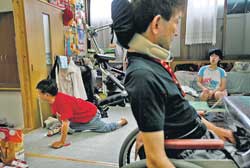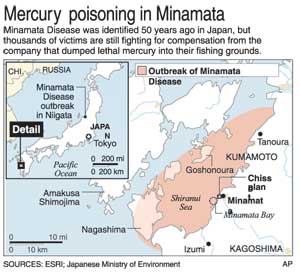
Ravages of Minamata50 years later, many victims of Japan's worst eco-disaster still struggle for redress SHIRANUI SEA, Japan (AP) - The dawn is still only a faint glow beyond distant mountains, but fisherman Akinori Mori and his wife, Itsuko, are already hard at work on their boat, reeling in nets of squid, fish and crabs. Nothing about this placid scene reveals that Japan's worst environmental disaster unfolded here. Starting 50 years ago, whole neighbourhoods were poisoned by mercury-contaminated fish from these waters. Thousands of people were crippled, and hundreds died agonizing deaths. Babies were born with horrifying deformities. Today, the tragedy known as Minamata Disease is only a dim memory to the rest of the world, and few outside Japan would recognize Chisso Corp. as the company that polluted Minamata Bay and the Shiranui Sea with deadly methylmercury. But for Akinori, 62, and Itsuko, 58, and many of the people living along these craggy coasts, the disaster never ended.
The Moris' parents - his father, both her parents - suffered the ravages of the disease: blinding headaches, crippling loss of sensation in their limbs, insomnia and dizzy spells. Both Akinori and Itsuko increasingly feel the disease in their own bones as they age, in painful hand and leg aches and loss of feeling and coordination from eating tainted fish as children. "Now it's starting in my hands and fingers," said Itsuko as she picked strips of seaweed from her fishing nets in the morning sun. "They're turning white and are all bent." Like the Moris, Japan has never fully recovered. Indeed, the disease played a large role in creating the Japan of today. It gave birth to the Japanese environmentalist movement, and like the Chernobyl nuclear meltdown and the Union Carbide chemical disaster in Bhopal, India, it became an international cause celebre. It forced the country to face up to the price of the industrial miracle it built out of the wreckage of World War II, encouraged other victims of such negligence to sue for redress, and forced authorities to be much more attentive to protecting the public from the mistakes of Japan Inc. But the struggle over Minamata is far from finished. At least 2,000 victims have died. Even now, courts are forcing the government to recognize more victims, which some estimate at as many as 30,000. Many are confined to wheelchairs or bed, complaining that diagnosis and treatment are haphazard and inadequate. Lawsuits for further compensation continue. The government still refuses to conduct an epidemiological study to determine the full scope of the poisoning.
"Minamata Disease has been going on for 50 years, but it still hasn't been resolved," said Takeko Kato, managing director of Hotto Hausu, a vocational aid center for victims in Minamata. "The country isn't helping these people enough." Silent disaster. The disaster in Minamata Bay began in silence.In the early 1950s, growing numbers of fish were found floating dead in the bay, which feeds into the Shiranui Sea. Then crows fell dead from the sky or crashed into rocks. Cats started gyrating in a bizarre "dance" before dropping dead. People were next. By the mid-1950s, villagers started suffering dizzy spells and troubles in walking and speaking. Growing numbers fell into convulsions, wasted away and died. The name Minamata Disease was coined in 1956. From the beginning, it was a malady no one wanted to talk about. Victims, shunned by neighbours who feared the illness was contagious, hid behind closed doors. Fishermen suffered symptoms in silence, terrified that word of the disease would wreck their livelihood. Often it was the people most in danger who fought doctors trying to help them. "They always said there's no Minamata Disease around here," said Shigeo Ekino, a scientist at Kumamoto University who has been researching victims since 1971. "Because if the journalists wrote the disease was here, the price of the fish would drop." Economics also insulated the culprit from blame for the methylmercury it dumped during the production of the chemical acetaldehyde, used to manufacture various products including pharmaceuticals. In the 1950s, Chisso was a shining triumph in Japan's feverish push for postwar economic development, and it held both bureaucrats and Minamata locals in awe -- an untouchability that allowed it to refuse for more than a decade to accept responsibility. The government, bent on industrial growth at any cost, did what it could to keep news of the disease quiet. Hoping to hide the source of the poisoning, Chisso rerouted its wastewater, thereby polluting a much larger area. The company continued to dump mercury in the waters with impunity until 1968. "The whole country was so caught up in high growth ... that it was easy to overlook things," said Timothy George, a historian at the University of Rhode Island and author of "Minamata: Pollution and the Struggle for Democracy in Postwar Japan." Chisso first offered "sympathy money" to small numbers of victims and fishing cooperatives in 1959, though it denied culpability. After the government declared it at fault, the company had to pay much larger compensation packages in the 1970s. Additional victims received money in the 1990s. Still, critics say the collusion between government and industry continues to protect the company from the full cost of its crimes. The government, for instance, has adhered to strict criteria that severely limited the number of "certified" victims eligible for the largest of the compensation packages -- only 2,960, including nearly 700 from a separate mercury poisoning case involving a different company in northern Japan. Of those, 2,078 have died. The legal battle continues. In a landmark decision, the Supreme Court ruled in 2004 that the government was responsible for the spread of the disease. Since then, an additional 12,000 people have become eligible for medical assistance, though not full certification, and the government is working on a plan to expand compensation to more than 5,000 additional people demanding recognition. "You've had this strange resurgence in recent years. Suddenly, you've had lots more people who wanted compensation for Minamata Disease," said George. One reason is that Japan is aging and more attention is paid to the welfare of the elderly. Another is that formerly taboo subjects are confronted more directly in media and society, and victims care less about what the neighbours will say. As the country has become richer, the focus has shifted from all-out industrialization to improving quality of life. As Japanese democracy has broadened and become more inclusive, courts have become more accepting of claims against big business. Full disclosure, however, is still far away. |
|| Front
Page | News | Editorial | Columns | Sports | Plus | Financial
Times | International | Mirror | TV
Times | Funday
Times || |
| |
Reproduction of articles permitted when used without any alterations to contents and the source. |
© Copyright
2007 Wijeya
Newspapers Ltd.Colombo. Sri Lanka. All Rights Reserved. |

